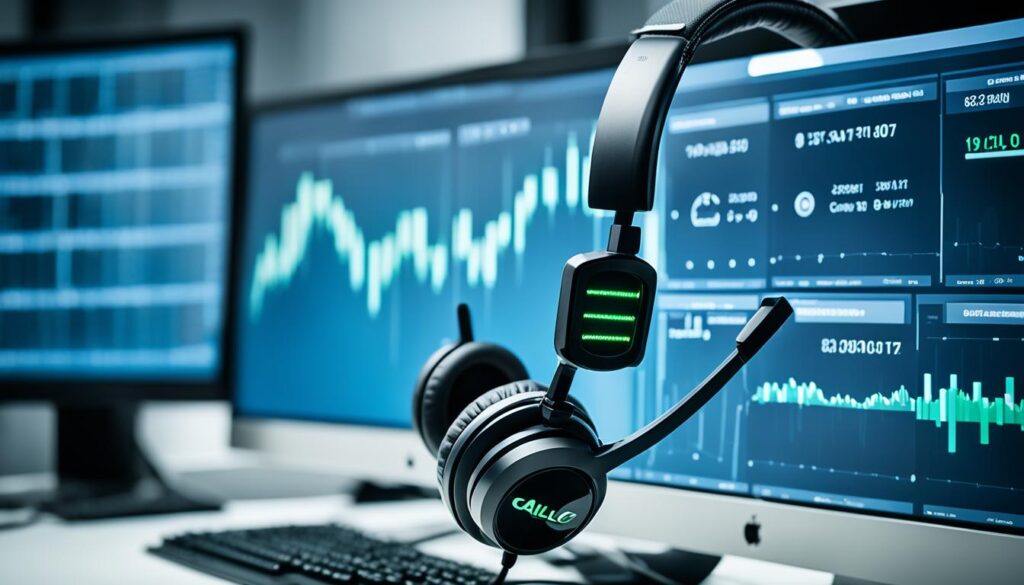Welcome to our latest article on optimizing average handle time (AHT) in call centers. If you’re looking to improve call center efficiency and enhance customer service metrics, you’ve come to the right place.
Call centers play a crucial role in delivering exceptional customer experiences. AHT, the average amount of time a customer call takes from start to finish, is a key metric in evaluating call center performance. By reducing AHT, call centers can streamline operations, improve customer satisfaction, and achieve cost savings.
In this article, we will explore why AHT is an important call center metric, how to accurately calculate AHT, the advantages of reducing AHT, tips to lower AHT while improving customer satisfaction, the connection between AHT and customer experience, and strategies for speeding up customer communications to reduce AHT.
Whether you’re a call center manager, supervisor, or agent, optimizing AHT can lead to significant improvements in call center efficiency and customer service. Let’s dive in and uncover the best practices for achieving AHT optimization.
Why is Average Handle Time an Important Call Center Metric?
Average Handle Time (AHT) plays a critical role in evaluating the performance and efficiency of call centers. As a call center supervisor, understanding the importance of AHT is crucial for optimizing call center operations and delivering exceptional customer service. Let’s explore why AHT is a vital call center metric and how it directly impacts call resolution time, agent productivity, and overall call center performance.
High AHT can significantly impact call center performance in several ways. Firstly, it directly affects call resolution time. Longer handling times can lead to increased wait times for customers, resulting in frustration and potentially negative customer experiences. By ensuring an optimal AHT, call centers can reduce call resolution time, allowing agents to handle more calls efficiently and promptly.
A high AHT also affects agent productivity. When agents spend excessive time on each call, it limits their ability to handle a larger volume of calls, reducing overall productivity. By focusing on reducing AHT, call centers can empower agents to handle more calls within their shift, thereby increasing agent productivity and improving operational efficiency.
Furthermore, AHT is crucial in monitoring and evaluating call center performance. By tracking AHT, supervisors can identify areas where improvements can be made, whether it’s optimizing call routing, implementing more efficient processes, or providing additional training to agents. AHT serves as a performance benchmark, enabling call centers to identify opportunities for enhancing customer service and reducing costs.
“A low AHT indicates efficient call handling, which can lead to higher customer satisfaction, improved agent performance, and decreased operational costs.”
To accurately measure and evaluate AHT, call centers need to collect accurate data on various call handling metrics, including talk time, hold time, and wrap-up time. By analyzing this data and continuously striving to improve AHT, call centers can enhance their customer service operations, meet customer expectations, and drive long-term success.
| Benefits of Optimizing AHT |
|---|
| Improved call resolution time |
| Enhanced agent productivity |
| Increased customer satisfaction |
| Reduced operational costs |
| Efficient call center performance |
Optimizing AHT not only benefits call centers but also elevates the overall customer experience. By reducing call handling time, customers spend less time waiting, resulting in higher customer satisfaction levels. In turn, satisfied customers are more likely to become loyal advocates and positively impact a call center’s reputation.
Therefore, call centers must prioritize AHT as a vital performance metric. By focusing on reducing AHT, call centers can enhance call resolution time, agent productivity, and call center performance, leading to improved customer satisfaction and business success.

How to Calculate Average Handle Time
Calculating Average Handle Time (AHT) is essential for understanding the efficiency and productivity of a call center. AHT takes into account factors such as talk time, hold time, wrap-up time, and the number of calls handled. By accurately calculating AHT, call center managers can make informed decisions about improving call center performance to meet customer expectations.
To calculate AHT, you can follow these steps:
Determine the Time Period
Decide on the specific time period you want to measure. This could be an hour, a day, a week, or any other interval that suits your needs.
Collect the Data
Collect the necessary data for calculating AHT. This includes:
- Talk Time: The time spent by agents in conversation with customers
- Hold Time: The time customers spend on hold during the call
- Wrap-up Time: The time agents spend after the call to complete necessary tasks such as note-taking or updating customer records
- Number of Calls Handled: The total number of calls handled by the call center during the specified time period
Calculate the Average
Once you have the data, you can calculate the AHT using the following formula:
AHT = (Talk Time + Hold Time + Wrap-up Time) / Number of Calls Handled
This formula gives you the average amount of time it takes for a call to be handled in your call center during the specified time period.
It’s important to note that AHT can vary across different departments or teams within a call center. Therefore, it’s helpful to calculate AHT for each specific area to identify any discrepancies and areas for improvement.
Monitor and Manage AHT
Service Level Agreements (SLAs) and call center Key Performance Indicators (KPIs) can help in monitoring and managing AHT. SLAs define the target AHT that the call center aims to achieve, while KPIs provide ongoing performance measurements. By setting realistic targets and continuously tracking AHT, call center managers can identify trends, make necessary adjustments, and drive improvements in call center efficiency and customer satisfaction.
Remember that AHT is just one metric among many that indicates call center performance. It’s important to consider other factors such as customer satisfaction ratings, first call resolution rates, and agent productivity to gain a holistic understanding of call center operations and make data-driven decisions.
AHT Calculation Example
| Talk Time (minutes) | Hold Time (minutes) | Wrap-up Time (minutes) | Number of Calls Handled |
|---|---|---|---|
| 5 | 1 | 2 | 20 |
| 7 | 2 | 3 | 15 |
| 4 | 3 | 1 | 25 |
In this example, let’s calculate the AHT:
AHT = (5 + 1 + 2 + 7 + 2 + 3 + 4 + 3 + 1) / (20 + 15 + 25)
The total sum of talk time, hold time, wrap-up time is 28, and the total number of calls handled is 60. Therefore, the AHT for this period would be:
AHT = 28 / 60 = 0.47 minutes (rounded to two decimal places)
After calculating AHT, call center managers can analyze the results, identify trends, and take appropriate actions to optimize call center performance and enhance customer satisfaction.
Advantages of Reducing Average Handle Time
Reducing Average Handle Time (AHT) can bring numerous benefits to call centers, including improved customer satisfaction, enhanced call center efficiency, and cost reduction.
By minimizing hold times and providing quicker resolutions to customer issues, call centers can significantly improve the overall customer experience. Customers will appreciate the reduced waiting time and the efficiency with which their queries or concerns are addressed.
Furthermore, reducing AHT directly affects call center performance by increasing agent productivity and the number of calls handled. When agents spend less time on each call, they can handle a greater volume of calls, resulting in higher operational efficiency.
In addition to improving customer satisfaction and call center efficiency, reducing AHT can also lead to significant cost savings for call centers. By streamlining call handling processes and optimizing staffing levels, call centers can reduce operational expenses and achieve better resource allocation.
To summarize, focusing on reducing AHT offers a win-win situation for call centers. It leads to happier customers, improved operational efficiency, and cost reduction, ultimately contributing to the overall success of the call center.
Advantages of Reducing Average Handle Time
“Reducing AHT leads to improved customer satisfaction, increased call center efficiency, and cost savings.”
Reducing AHT offers numerous benefits for call centers:
- Enhanced customer satisfaction: Minimizing hold times and resolving customer issues more quickly improves the overall customer experience.
- Increased call center efficiency: Agents can handle a greater volume of calls when AHT is reduced, leading to improved productivity and operational efficiency.
- Cost reduction: Streamlining call handling processes and optimizing staffing levels can lead to significant cost savings for call centers.
To illustrate the impact of reduced AHT, let’s consider the following example:
| Call Center A | Call Center B |
|---|---|
| AHT: 10 minutes | AHT: 5 minutes |
| Average calls per day: 1000 | Average calls per day: 1000 |
| Operational cost per call: $5 | Operational cost per call: $5 |
In this example, Call Center B with a lower AHT of 5 minutes can handle the same volume of calls as Call Center A but in half the time. As a result, Call Center B can reduce operational costs by 50% compared to Call Center A.

Tips to Help You Lower Average Handle Times while Improving Customer Satisfaction
Lowering average handle times (AHT) is essential for call centers looking to improve efficiency and provide a better customer experience. By implementing the right strategies and utilizing various tools, you can achieve lower AHT without compromising on customer satisfaction. Here are some tips to help you optimize your call center operations:
1. Choose the Right Call Center Technology
Investing in the right call center technology is crucial for streamlining call handling processes and reducing AHT. Look for solutions that offer features such as intelligent call routing, automated call distribution, and integrated customer relationship management (CRM) systems. These tools help agents handle calls more efficiently, resulting in faster resolutions and reduced handle times.
2. Utilize Call Recordings for Training and Monitoring
Call recordings provide valuable insights into agent performance and customer interactions. By analyzing recorded calls, you can identify areas for improvement and provide targeted training to your agents. This helps them enhance their skills, handle calls more effectively, and ultimately reduce AHT. Furthermore, call recordings allow supervisors to monitor calls in real-time, providing immediate feedback and guidance to agents during customer conversations.
3. Build a Comprehensive Knowledge Base
A well-organized and searchable knowledge base is an invaluable resource for call center agents. When agents have easy access to a repository of information and solutions, they can quickly find answers to customer queries, reducing the time spent on each call. Ensure your knowledge base is regularly updated with the latest products, services, and frequently asked questions. This enables agents to provide accurate and efficient resolutions, further decreasing AHT.
4. Regularly Review Analytics Data
Analytics play a crucial role in identifying areas for improvement and optimizing call center performance. Regularly review key performance indicators (KPIs) such as first call resolution rate, average hold time, and customer satisfaction scores. Analyzing this data provides insights into bottlenecks and areas where AHT can be reduced. Use analytics to identify common call topics, recurring issues, or potential process improvements that could lead to faster call resolutions and improved customer satisfaction.
By implementing these tips, your call center can effectively lower AHT while maintaining high levels of customer satisfaction. Remember, every second counts in improving operational efficiency and delivering exceptional customer service.

| Call Center A | Call Center B |
|---|---|
| 2019 | 200 seconds |
| 2020 | 180 seconds |
| 2021 | 150 seconds |
How Average Handle Time is Tied to Customer Experience
Average Handle Time (AHT) plays a crucial role in shaping the customer experience in call center operations. While reducing AHT is important for optimizing efficiency, it should never be done at the expense of providing quality customer service. Call center operations and customer experience managers should review call data to find the right balance between AHT and customer satisfaction.
By focusing on improving AHT without compromising the customer experience, call centers can elevate their Net Promoter Score (NPS) and establish strong customer relationships. A positive customer experience is directly linked to increased NPS scores, which reflect customer loyalty and advocacy. AHT reduction strategies should be implemented in a way that enhances the overall customer journey and improves customer satisfaction levels.
Striving for Customer Centricity
Customer experience should always be at the forefront of call center operations. When striving to reduce AHT, it’s important to consider the impact on customer satisfaction. AHT reduction efforts should be complemented by initiatives that prioritize effective communication, empathetic interactions, and proactive problem-solving. By putting the customer first, call centers can ensure that AHT reduction initiatives align with the goal of enhancing the overall customer experience.
“AHT reduction initiatives should align with the goal of enhancing the overall customer experience.”
Additionally, call center agents should be equipped with the necessary tools and knowledge to efficiently handle customer interactions. By investing in comprehensive agent training programs, call centers can enhance agent expertise, enabling them to provide faster and more effective resolutions to customer queries.
Utilizing Data for Continuous Improvement
Data analysis plays a crucial role in optimizing AHT while maintaining a focus on the customer experience. Call centers should regularly analyze call data to identify patterns, trends, and areas for improvement. This data-driven approach allows call centers to identify bottlenecks in the customer journey and implement targeted improvements to enhance the overall experience.
By leveraging call analytics and customer feedback, call centers can identify specific pain points that contribute to longer handle times. This enables them to implement targeted initiatives to streamline processes, reduce customer effort, and provide quicker resolutions. Regular review of data allows call centers to make informed decisions and continuously improve call center operations to deliver exceptional customer experiences.
To summarize, AHT reduction is directly tied to the customer experience. By striking the right balance between AHT and customer satisfaction, call centers can enhance their NPS scores, build strong customer relationships, and ensure long-term business success.

Ways to Speed Up Customer Communications and Reduce Average Handle Time
Speeding up customer communications and reducing average handle time (AHT) is crucial for call centers looking to provide efficient and prompt customer service. By implementing strategic measures, such as omnichannel contact routing, call center training, and minimizing call tangents, call centers can optimize their operations and improve their overall customer experience.
One effective strategy is implementing omnichannel contact routing, which ensures that customer calls and messages are efficiently distributed to the most appropriate agents. This routing system allows for seamless communication across various channels, such as phone calls, emails, live chats, and social media, enabling agents to handle customer inquiries promptly and effectively.
Comprehensive call center training plays a vital role in improving efficiency and reducing handle times. By providing agents, especially new and struggling ones, with the necessary skills, knowledge, and resources, call centers can enhance their performance and response times. This training should focus on effective communication, problem-solving techniques, and utilizing call center technology efficiently.
Another essential aspect to consider is minimizing call tangents. By encouraging agents to stay focused on the customer’s inquiry and avoiding unnecessary digressions, call centers can significantly reduce AHT. Agents should be trained on active listening and professional etiquette to guide conversations towards productive resolutions, ensuring that customers receive the assistance they need in a timely manner.
By implementing omnichannel contact routing, providing comprehensive call center training, and minimizing call tangents, call centers can effectively reduce AHT and optimize their operations. These strategies not only improve the efficiency of customer communications but also contribute to a faster and more efficient resolution of customer inquiries. By prioritizing speed and effectiveness, call centers can enhance their customer service capabilities and ultimately drive customer satisfaction.
FAQ
What is average handle time (AHT) in a call center?
Average handle time (AHT) is the average amount of time it takes for a customer call to be handled from start to finish. It includes factors such as talk time, hold time, and wrap-up time.
Why is AHT an important call center metric?
AHT is important because it measures call center efficiency, agent productivity, and overall call center performance. It affects customer satisfaction and operational costs.
How is average handle time calculated?
AHT is calculated by adding the total duration of all calls and dividing it by the total number of calls. It’s important to consider factors such as talk time, hold time, wrap-up time, and the number of calls handled.
What are the advantages of reducing average handle time?
Reducing AHT improves customer satisfaction by minimizing hold times and providing quicker resolutions. It also enhances call center performance and can lead to cost savings through more efficient call handling and staffing optimization.
How can I lower AHT while improving customer satisfaction?
You can lower AHT by implementing efficient call center technology, leveraging call recordings for training and monitoring, building a comprehensive knowledge base, and regularly reviewing analytics data to identify areas for improvement.
How is average handle time tied to customer experience?
AHT directly impacts customer experience. While it’s important to reduce AHT, it should never be done at the expense of providing quality customer service. Finding the right balance between AHT and customer satisfaction is crucial for call center operations.
What are some ways to speed up customer communications and reduce AHT?
Implementing omnichannel contact routing, providing comprehensive call center training, and minimizing call tangents can help speed up customer communications and reduce AHT.
